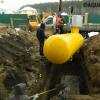Without a doubt, if you keep in mind the laid water and sewer communications, the general appearance of your bathroom or toilet will not be the most presentable. At the same time, it is not recommended to wrap them tightly in the wall, because in case of malfunctions all the masonry will have to be dismantled. In this article we will talk about how to close the pipes in the toilet with plastic to disguise them without constructing a capital wall.
Selection of necessary materials
The process of selecting material for the construction of wall panels is carried out taking into account the following requirements of regulatory documents:
- Easy to work with material. Since the toilet, as a rule, is a rather compact room, the installation of the wall panel requires material that does not take up much space, and which would be easy to operate.
- Health safety. In a toilet room, the microclimate is usually characterized by elevated temperature and humidity. Therefore, you need to choose a material that does not emit toxic substances for health in such conditions.
- Oxidation and corrosion resistance. To build a frame for pipes in the toilet, the material for it must be not only resistant to corrosion, but also preventing its spread to other surfaces.
All of these requirements correspond to several varieties of building materials.

In particular, the most popular options are:
- Panels made of plastic.
- Moisture-resistant drywall.
- MDF boards.
- Moisture-resistant plywood.
It is worth noting that for use at home, it is plastic panels that are most in demand. Nevertheless, even if you have finally decided to hide the pipes in the toilet with plastic panels, figure out how harmoniously this material will look against the background of the general interior of your toilet room.
This is important for the reason that in case of any discrepancies in the color scheme, additional costs will be required, while the lack of the right material can be purchased at any time.
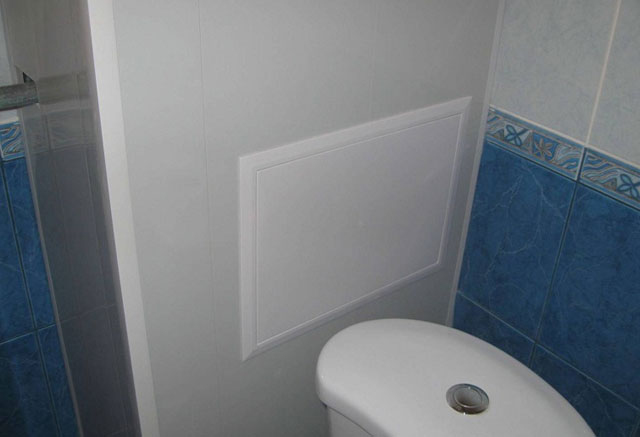
Here are some of the advantages of lining the pipes in the toilet with plastic panels:
- works on closing communications with plastic panels do not require significant physical and time costs;
- the weight of such a false wall is very small, and for urgent or scheduled repair of communications it is very easy to disassemble;
- since the plastic is smooth and not prone to corrosion, it is considered one of the most hygienic materials for use in the bathroom;
- such panels perform a noise insulation function;
- a wide range of colors of this material makes it possible to choose a suitable design of panels to harmoniously fit them into the interior of the bathroom;
- for a fairly small amount, you can get a fairly high-quality and durable material.
Nevertheless, plastic panels are also not without some drawbacks, the most significant of which is their low fire resistance. Although some manufacturers of such products claim that they have the property of self-extinguishing and are heat resistant, nevertheless, smoke emitted when plastic ignites can be very toxic.
Therefore, for safety reasons, if you decide to cover the pipes in the toilet with plastic panels, in no case do not smoke in the toilet and do not use sources of naked flame.
Instrumentation and installation technique
There are several ways to seal pipes in the toilet with plastic panels:
- Using PVC panels, you can directly mask the communication pipes themselves. To do this, around them you need to collect boxes of the appropriate size. The beauty of this approach is, firstly, in saving material, and secondly, it leaves more free space.
- You can completely close the pipes in the toilet with plastic panels, that is, build an additional wall. Of course, this way the situation in the bathroom will be more attractive, however, even without that, the small room will be further reduced in size.

Please note that to start work on masking the pipeline in the bathroom is only after a full check of their serviceability. This is important, because in the event of defects in the water supply or sewage pipes, all camouflage structures will have to be dismantled for repairs.
For work you will need the following tools:
- level;
- construction knife;
- hammer drill;
- self-tapping screws, screws or nails with dowels;
- guides and starting profile;
- plastic panels.
The process of installing plastic panels in the toilet
Before you go around the pipe with a PVC panel, you should markup under the supporting structure for plastic. Subsequent installation of the panels will be carried out on the frame, for the assembly of which it is necessary to determine the dimensions of the niche.
As a rule, all communications for plumbing and sewage in apartments take place in one place. To perform measurements of the area of \u200b\u200bwork, you can use tape measure. Experienced workers recommend sketching a small sketch of the frame on which to estimate the places of its fastening and indicate the exact dimensions of the skin. Please note that there must be some gaps between the plastic and the pipes.
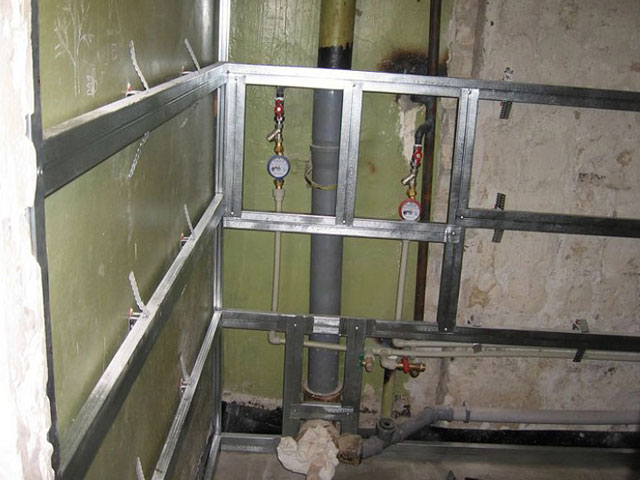
Pipes can only be closed if they are in good working order. It is advisable to replace the cast-iron pipes that have expired, with plastic analogues.
At the next stage, longitudinal wooden bars or guide profiles are fixed to the walls, floor and ceiling using dowels. Then, profile corners or a wooden rail are screwed to the structure in the upper and lower parts of the frame. The last step in the assembly of the frame is the fastening of horizontal rails or profiles with a step of 30-40 cm. Do not forget to provide inspection windows with doors in the frame, they are installed when the base assembly is completed.
After the frame is fully installed, you can proceed with the installation of the plastic panels.
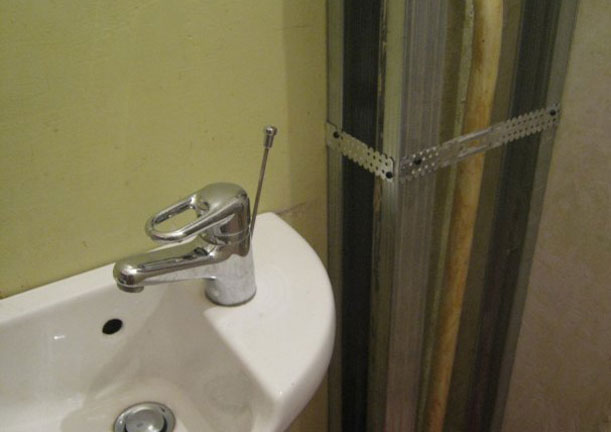
This base material can be attached in one of the following ways:
- on self-tapping screws or nails - to a wooden structure;
- on the clamps;
- using a construction stapler;
- on glue;
- on clips - if the frame is also plastic.
We draw your attention to the fact that fixing the false wall of plastic to glue will be quite strong, so if emergency repairs are necessary, it is unlikely to disassemble the structure without damaging the plastic. In this case, it is optimal to use self-tapping screws.
Panel Mount
Getting to the final stage of work on masking pipes in the toilet, you should perform the following actions:
- Close to the wall on the frame, you need to fix the start profile using self-tapping screws. Please note that it is fixed in such a way that the next panel to be mounted overlaps the screws.
- The next piece of plastic is inserted into the resulting groove and it is pushed close to the profile. The free end of the panel on the longitudinal bars is fixed with screws. By a similar technology, all wall panels are fastened.
- Next, a door is installed in the skinny walls.
- At the opposite end of the frame, another starting profile is installed so that the wall becomes finished. A similar method is necessary to close the end parts of the plastic at the ceiling and floor. Pay attention to the fact that, according to the regulations, a ventilation window with a cross section of at least 5 cm must be provided in the upper part of the duct.
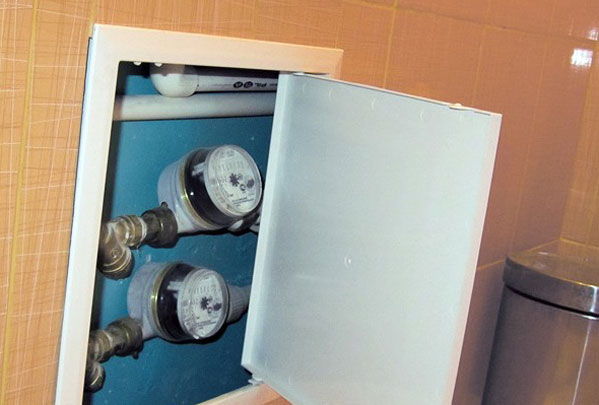
In conclusion, it is worth adding that in addition to all the above methods, there is another one that is acceptable for masking pipes in a small bathroom. In this case, you do not have to spend a lot of money and time. It's about the blinds. A box under them is installed on the ceiling. They can completely close the space from the ceiling to the floor, and if necessary, such roller shutters simply open - they are wound on a shaft mounted under the ceiling.
With the help of such devices you can give the interior an original sound and save space. Fortunately, there are a lot of colors for such products, and the time for their installation will require much less than the installation of the frame under a plastic box. In addition, you can carry out all the work yourself.
Repair in the toilet includes not only the repair work itself, but also the decoration of the room. Finishing, design, installation of additional elements - all this remains at your discretion. But even with cosmetic repairs, it is important to ensure that the pipes do not spoil the general appearance of the room and are hidden. In order to close the structure, many methods were invented using various materials. Consider the main ones.
Drywall
Benefits of using this material in order to close sewer pipes in the toilet:
- After working on the box, you can perform any type of finish (wallpaper, tile, paint);
- Simplicity of work;
- Low cost of material;
- Constructions are completely hidden.
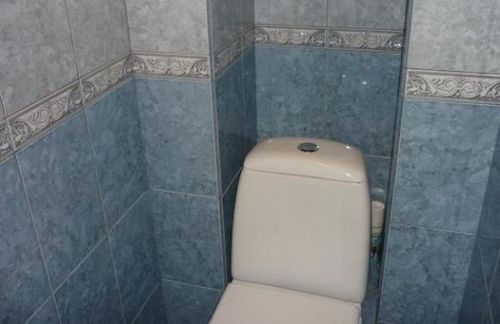
However, there are also disadvantages. When working with your own hands, you will have to make an effort and spend time, as this is a rather laborious job.
So, before performing work with drywall, you need to complete the frame. For its installation, profiles or wooden rails are required. Then, when the frame is made, under its dimensions are cut, with the help of a mounting knife, drywall panels. Then, at the ends of them, the edge is removed by means of a plane. Self-tapping screws are attached to the chamfer. Panels are mounted on the frame using self-tapping screws. Then the drywall construction can be decorated. For this, coloring compounds are used, wallpapers are glued.

Before you start working with drywall, look at the training photo and get acquainted with the basic recommendations:
- In the box there should be revision hatches;
- When working with self-tapping screws, be careful, they should not harm the design of the pipeline itself;
- The dimensions of the box must be adjusted so that it does not serve as an obstacle;
- If you want to reduce the sounds emanating from the structures, you can mount a noise isolator in the box.

In order for you to be able to easily hide the sewer pipes in the toilet using drywall, we have prepared a special training video and photo for you. They will be very useful for you when doing the work yourself.
Plastic panels
The second common way to close the pipes in the toilet is to hide them through plastic panels. Consider the benefits of this option:
- Simple and quick installation;
- Lightness, which also facilitates installation, and also makes dismantling easier;
- Democratic cost relative to other technologies using other materials;
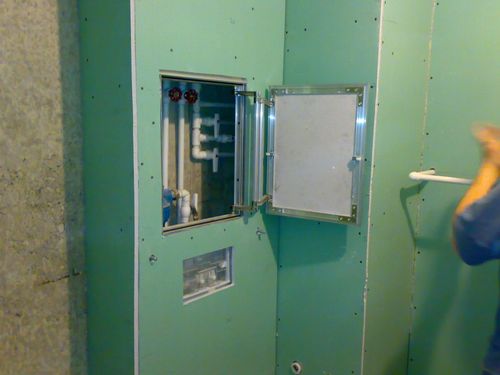
- A variety of design solutions;
- Durability;
- Resistance to moisture;
- Hygiene
In order to close the pipes in the toilet with plastic panels, you will need the following tools:
- Hammer drill;
- Level;
- Knife for installation work;
- Self-tapping screws;
- Guiding and starting profiles;
- Screwdriver.
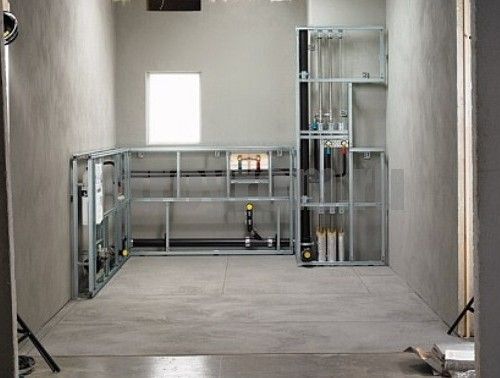
In order to close the sewer pipes in the toilet with plastic panels, the following technologies can be applied:
- Solid wall decoration. The panels are mounted on the entire surface of the wall, which allows you to hide the structure. Advantages: aesthetics, a variety of design options. Cons: reducing free space in an already small room;
- The decoration of the structures themselves. In this case, the box is carried out only around the structures. Advantages: saving on materials, ease of installation, free space in the room is not reduced.
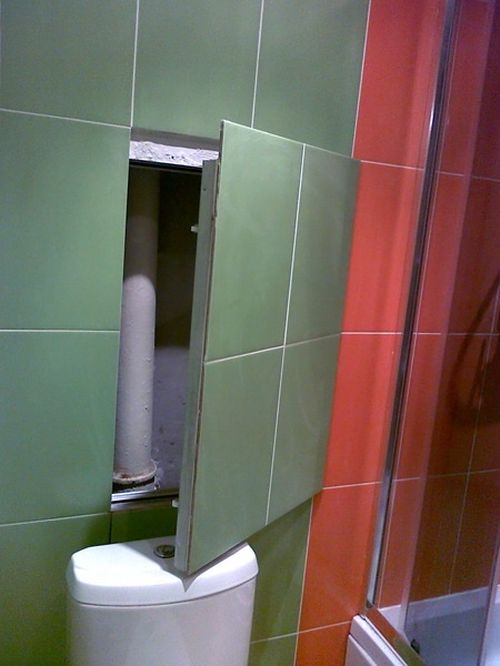
Consider how to install plastic panels in order to close the pipes in the toilet, with your own hands:
- On the surface of the wall, marking is applied for the installation of profiles;
- Mounted, pre-trimmed with mounting scissors, profiles to the surface. Of these, a frame is made, on which the material will then be attached;
- If necessary, you can make the frame of metal or profile. If wooden blocks are used, a coating should be applied on them to prevent the appearance of fungus. In the case of metal profiles - choose a galvanized version, since such structures will not be covered by corrosion;
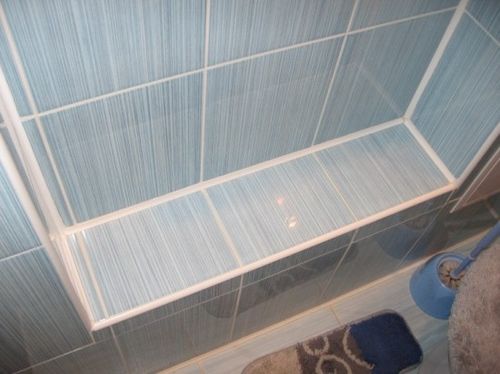
- Profiles are mounted using a punch and dowels. The distance between the elements must be maintained. The minimum distance is 30-40 cm.
After all these preparatory work, you can proceed with the installation of plastic panels on the frame. They are fastened with self-tapping screws.
It is simple to close the pipes in the toilet with your own hands, this does not require much effort. The materials for this (drywall, plastic panels) are quite affordable. You can hide the pipes in the toilet by using other technologies. For example, plastic panels can be replaced with plywood. You can hide sewer pipes in the toilet through their decoration. For example, decorate them with a mosaic. You can see the whole variety of solutions in the photo.
Many of our fellow citizens live in houses built in socialist times, when the main task of builders was to provide affordable housing for the population, and luxury and comfort often faded into the background. Then it was not customary to hide water communications, therefore, to this day in modern apartments, pipes in the toilet room often pass either in the corner or are located in an open niche, right before your eyes.
Not surprisingly, the desire to make the interior of the toilet room more refined and modern leads to the question of how to sew pipes in the toilet? This can be done in two ways, which depend directly on the location of the pipes in the room.
Installation of a duct box in a corner
If plumbing is located in the corner of the toilet room, best solution hide them from prying eyes may be mounting boxes made of plastic or drywall.
Due to the simplicity of the design of such a box, even a layman can cope with its construction.
Getting started, it is necessary to prepare the following materials and tools:
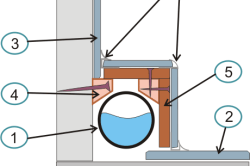
Box design diagram: 1 - Pipe, 2 - Tile, 3 - Wall tile, 4 - Bar on which the box rests, 5 - Box, 6 - External and internal plastic corners.
- rack profile;
- guide profile;
- moisture resistant drywall (the amount depends on the size of the structure under construction) or plastic panels;
- several metal screws with a length of 25 mm and a diameter of 3.5 mm;
- the same number of dowels with a length of 40 mm and a diameter of 6 mm;
- level;
- several metal screws;
- screwdriver;
- scissors for metal;
- pencil;
- plumb line;
- roulette;
- hammer drill;
- hacksaw;
- wire mesh for metal No. 100;
- polyurethane foam.
To sew pipes in the toilet competently and for a long time, they should be replaced. If the pipes are old enough, they may soon leak. As a result, the entire built structure will have to be disassembled. To avoid this, experts recommend replacing old pipes with new ones before installing the box.
In order for the frame of the future box to be strong enough and last for a long time, it must be made of rack and guide profiles made of metal. In addition, the galvanized sheet from which the profiles are made provides high resistance of the frame to the appearance of rust.
The manufacture of a frame for drywall or plastic panels, and then the box itself can be divided into the following stages:
- Marking the area.
- Setting profiles.
- Fastening racks.
- Plasterboard or paneling.
When all the necessary material and tools are prepared, you can begin to work. Instruction:
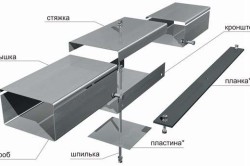
- With the help of a pencil, a building level and a plumb line, the contours of the future structure are marked on the floor, walls and ceiling. The verticality of the contours is checked by the level, the horizontalness - by a plumb line.
- According to the drawn lines, three vertical guide profiles are installed: two on the walls, one in the center, creating an angle with a size of 90 0. Profiles are attached to ceilings with dowels and screws.
- Tape measure measures the distance between profiles.
- This distance is measured on the rack profile.
- With the help of scissors, several blanks are cut out for metal. Their number depends on the height of the structure.
- The blanks are inserted between each of the guide profiles mounted on the wall and the central profile, fixed with metal screws.
- Plasterboard sheets or panels, previously cut to the width of the sides of the structure, are sewn to the formed frame with self-tapping screws. At the same time, the screws should be screwed into the drywall sheet so that their hats do not recess deep into more than 1 mm.
- If gypsum plasterboard sheets (plastic panels) screwed to the frame protrude beyond its borders, they are sawed off with a hacksaw and the edges are leveled with mesh No. 100.
- If there are gaps between the drywall and the walls, they are filled with foam.
When the design is ready, if desired, you can make its decorative processing. To do this, close all the seams in the box, the structure itself is primed and putty. After the putty has dried, the box can be pasted over with wallpaper or painted in the desired color.
We hide the pipes located in the niche
If water utilities are located in a special niche, this provides an opportunity not only to hide them, but also to install shelves for storing household chemicals and other household supplies. The main goal in this case is to sew up the pipes so that as much space as possible remains in the niche.
To achieve this will allow the layout of plumbing communications. When replacing old pipes with new ones, place them all in one corner, and only then sew and arrange the shelves. Arranged pipes should be placed in a box of drywall, while not forgetting about access to taps. In the box, you can make a special door or leave free space to ensure a sewer audit at any time.
After sheathing the pipes, a standard niche should leave about half a meter of free space. It is possible to arrange shelves in it or even organize a full-fledged locker. If you decide to place shelves in a niche, you can hide them with a small screen or blinds that are suitable in color to the interior of the toilet room.
In modern construction, when the market is saturated with building materials, the question of how to hide the pipes in the toilet inherited from socialist times does not look complicated. The main thing is to take two principles as a basis: the design must comply with the overall design of the room and not cause discomfort.
Any toilet in the apartment is the concentration of all kinds of pipes, differing both in purpose and in diameter. It has a sewer riser, a cold feed pipe passes and hot water, and sometimes heating pipes. In addition to the pipes are all kinds of taps, counters and filters that do not give the overall interior of the room a special charm.
There is no way to get rid of the web of these pipes and plumbing devices, for the simple reason that it is in the toilet that the communication systems least interfere with the inhabitants of the home. However, a rare lover of exoticism may like this intricacies of communication systems. Moreover, today there are many wayshow to hide pipes in the toilet.
The choice of materials for hiding pipes in the toilet

Getting to the solution of the question - how to close the pipe in the toilet, first of all, you need to decide on the suitable material. At the same time, focusing only on the aesthetic component is wrong. This is primarily due to the fact that the material used in the decoration of toilets and bathrooms must meet the following characteristics:
- the construction of the material should be lightweight and compactso as not to clutter up an already limited space;
- the material should not be subject to corrosion and the effects of chemicals used to maintain hygiene in the toilet;
- in case of temperature changes or an increase in moisture level, the material should not deform or change its structure.
But even given the strict selection criteria, there are a lot of materials for finishing or building various structures in the toilet. Plastic panels, a moisture-proof brand of drywall or plywood, MDF decorative boards and much more are perfectly suitable for the toilet. Well, finally, when choosing a material, it is necessary that it harmoniously fits into the overall interior of the toilet.
Options for sewing sewer and water pipes in the toilet
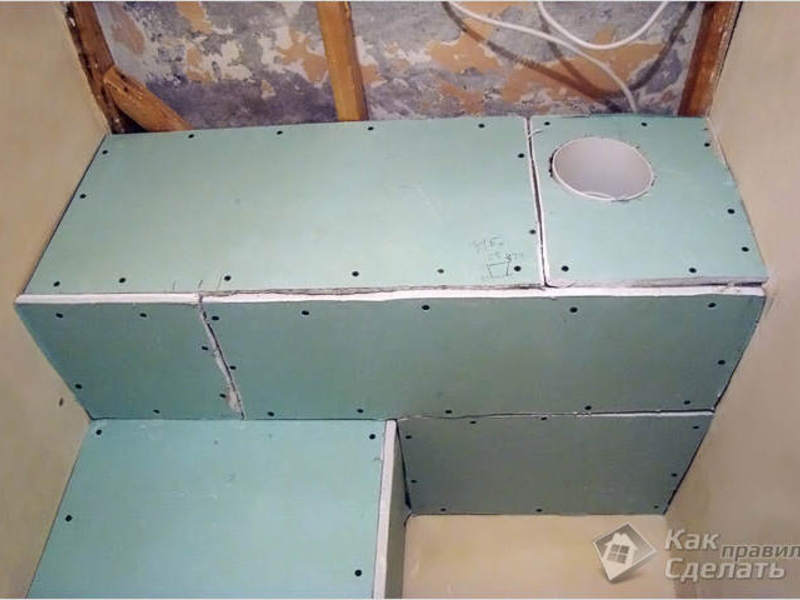
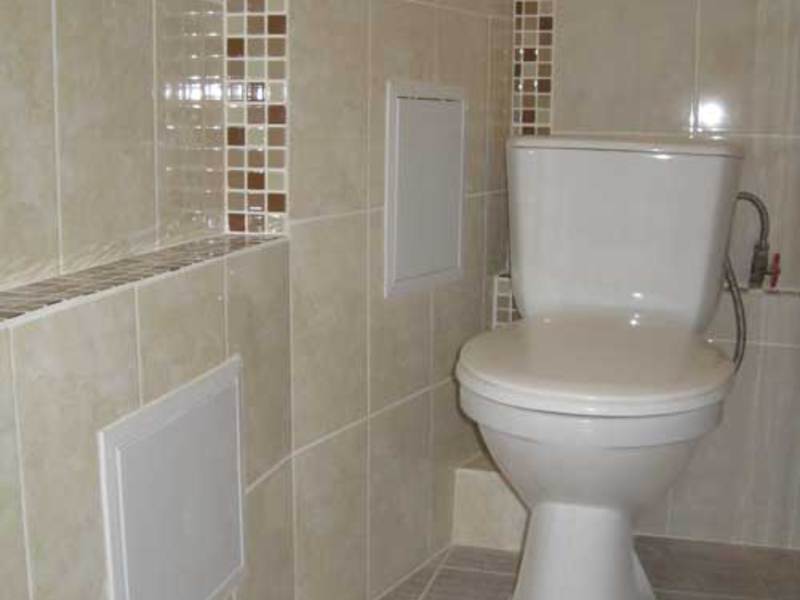
![]()
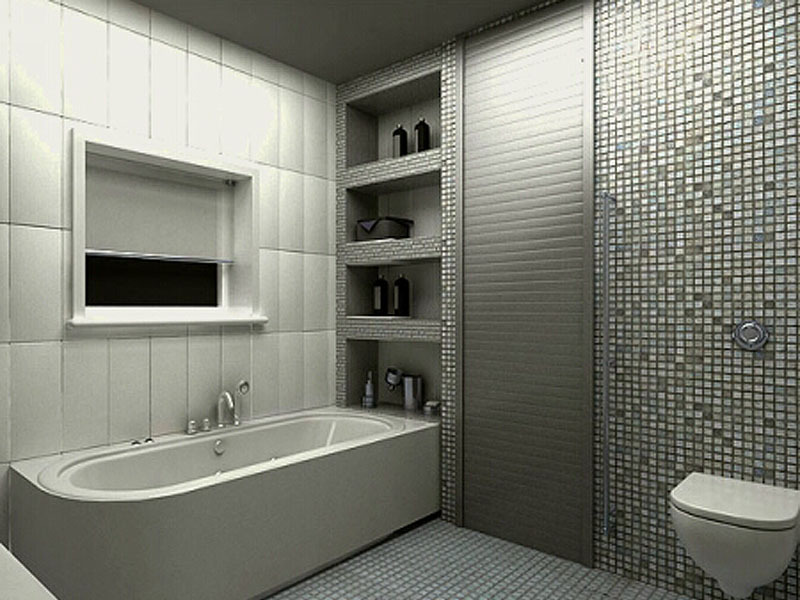

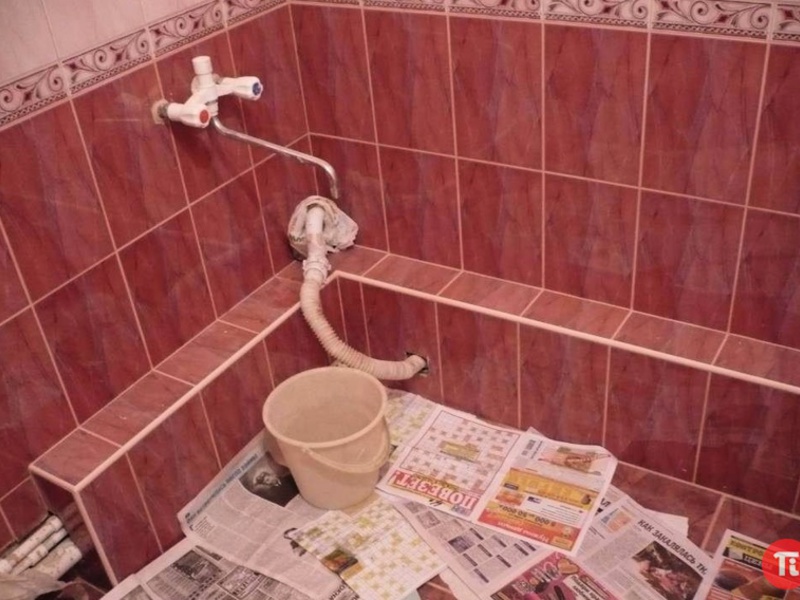
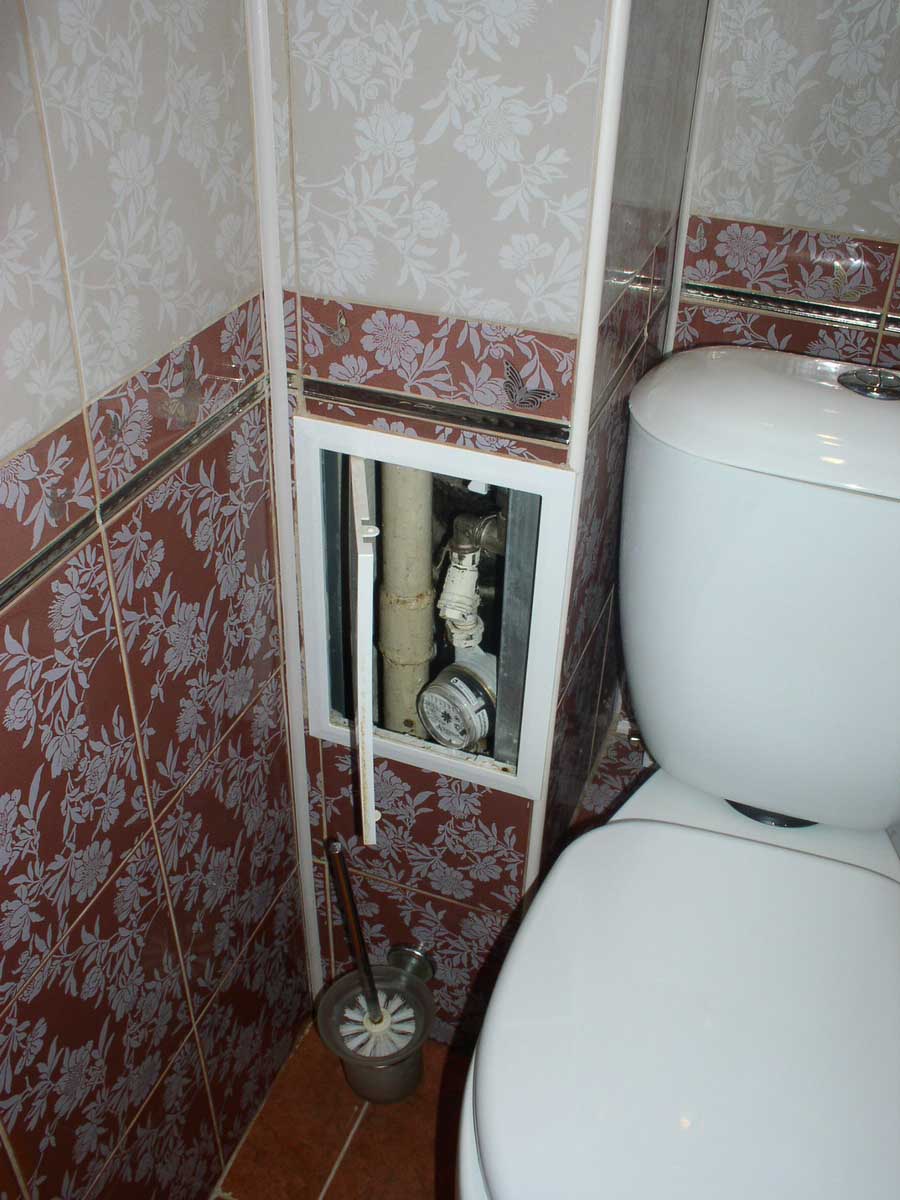
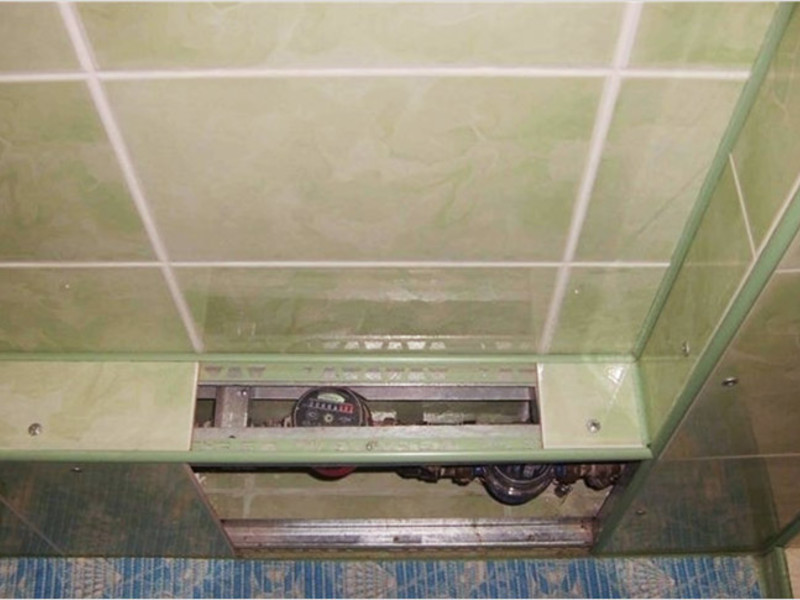
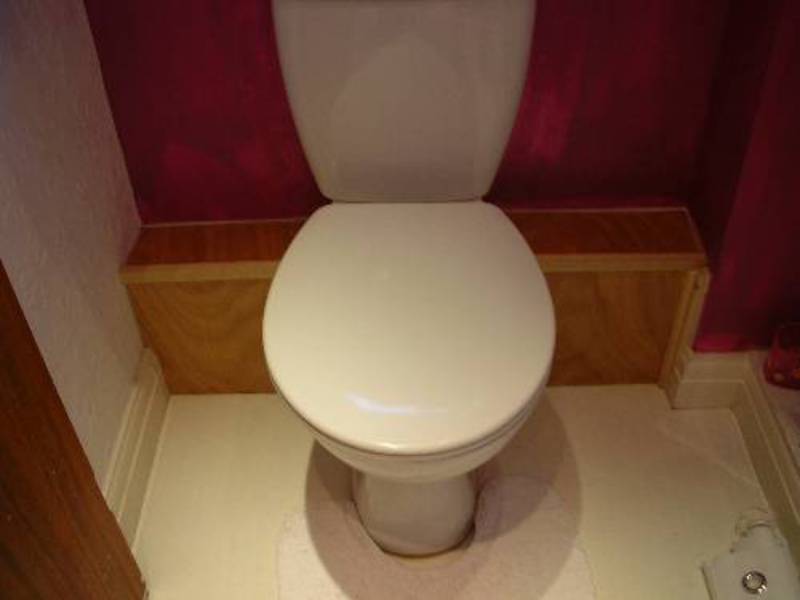
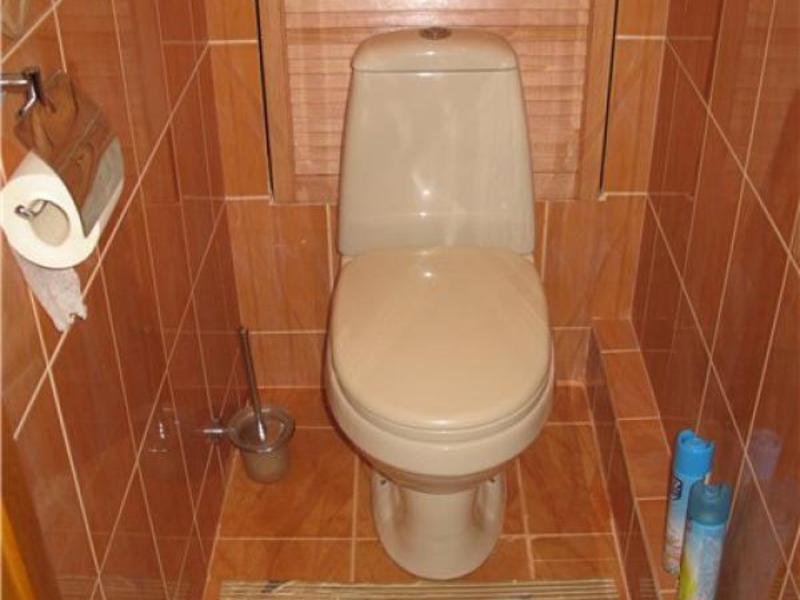
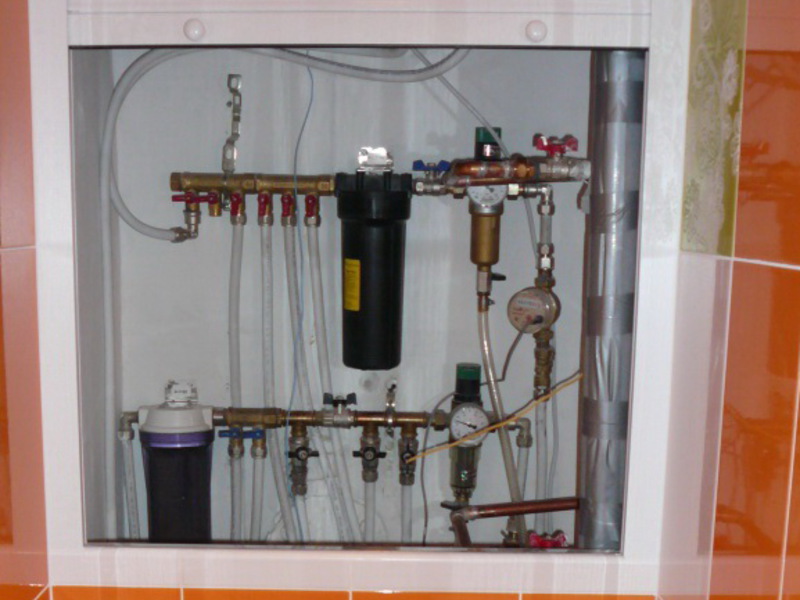
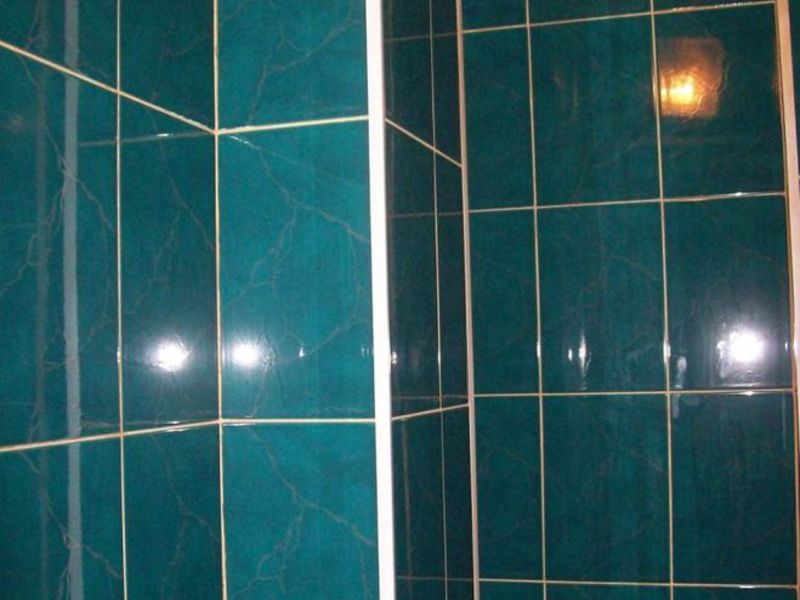
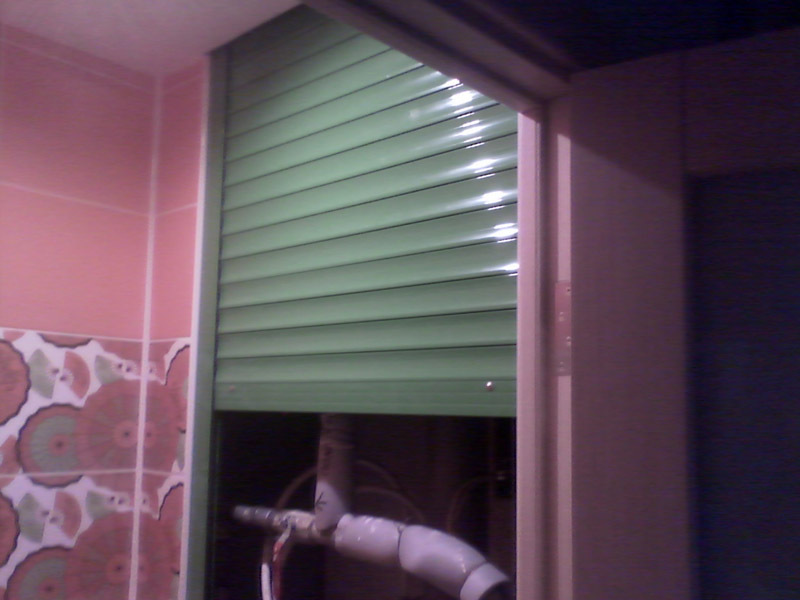
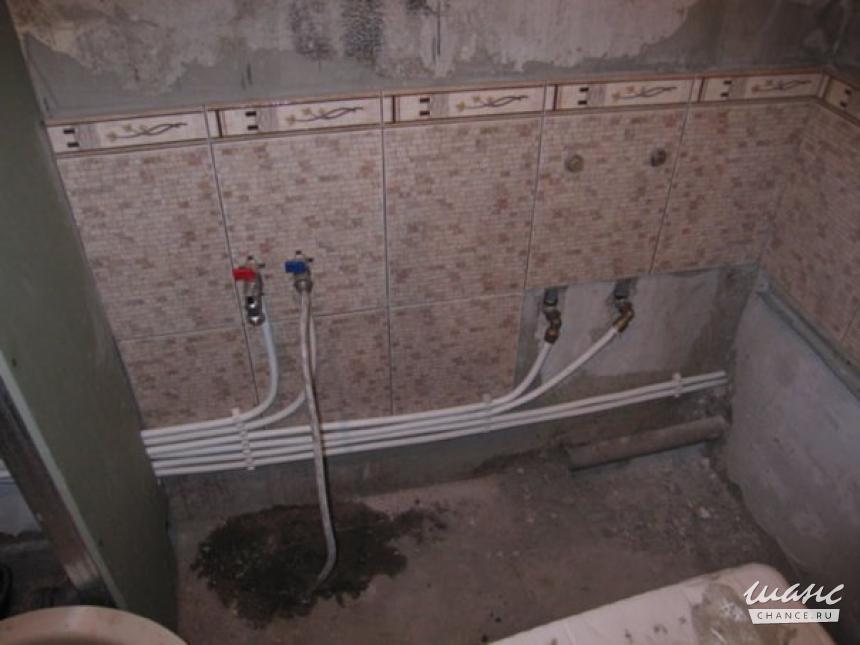
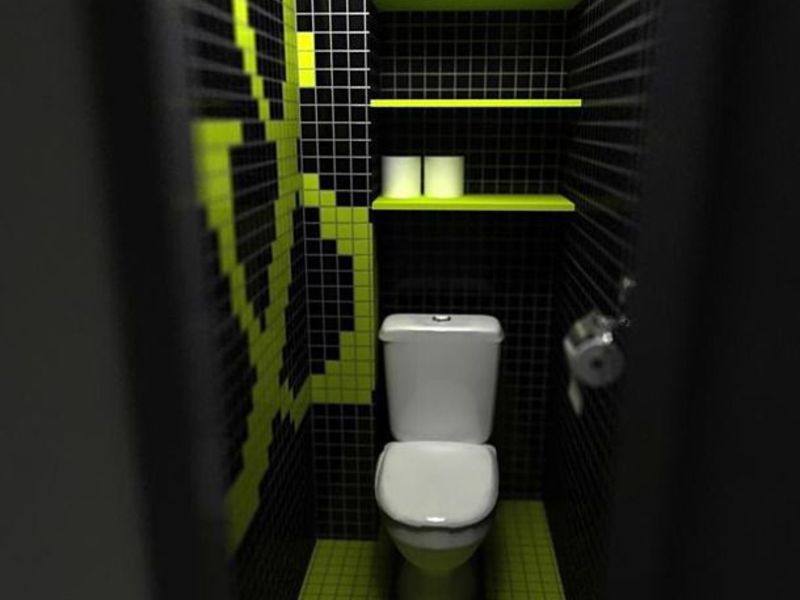
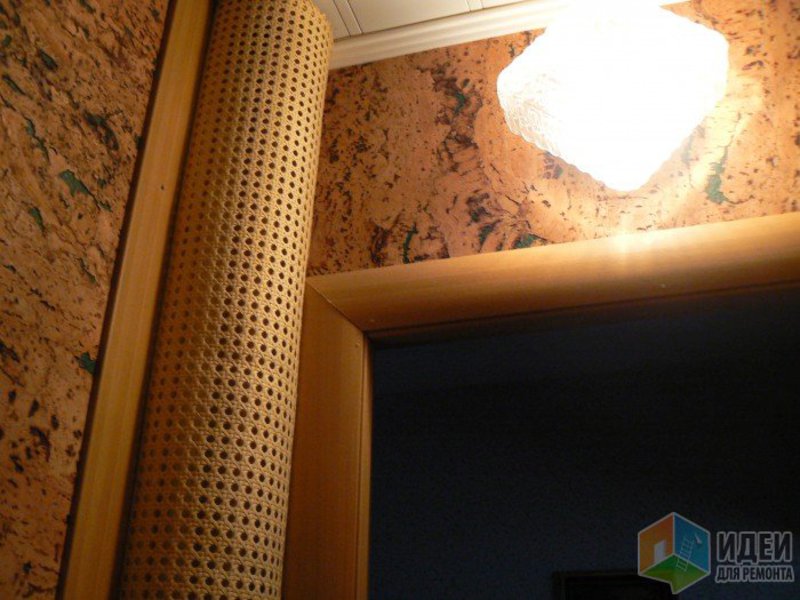
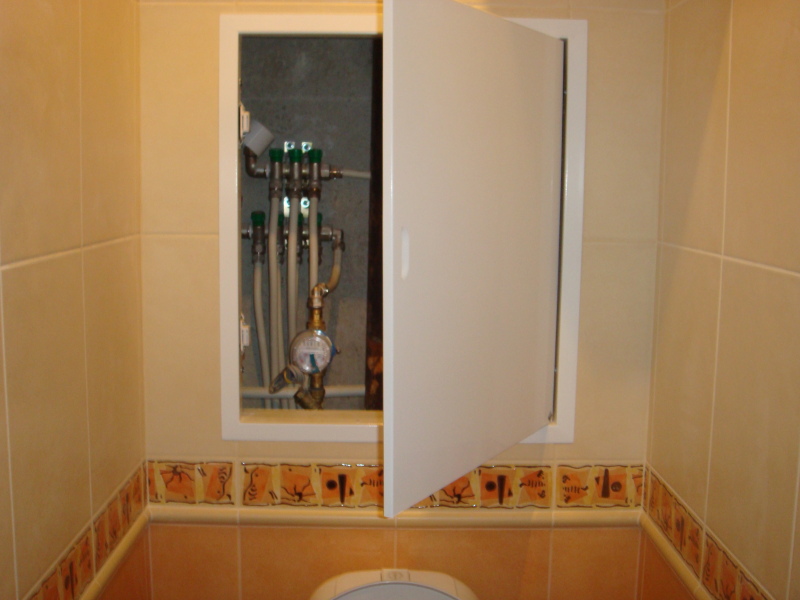
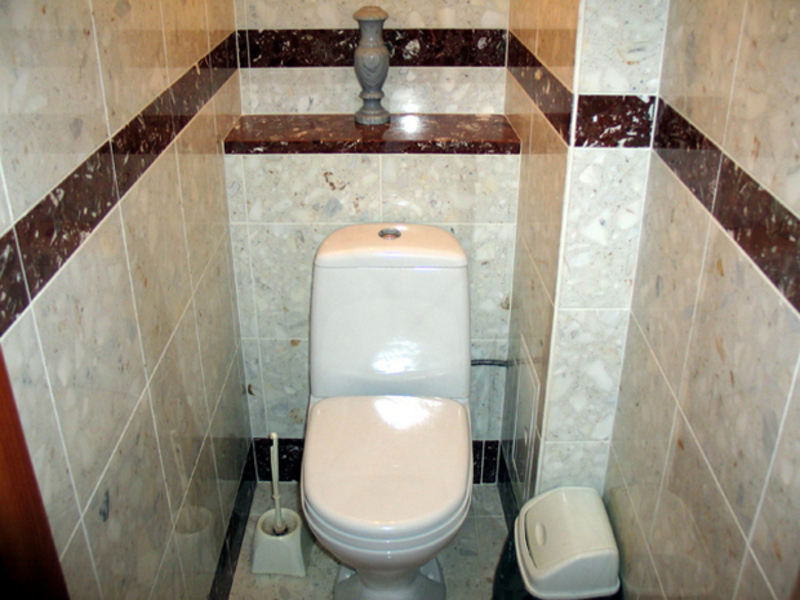
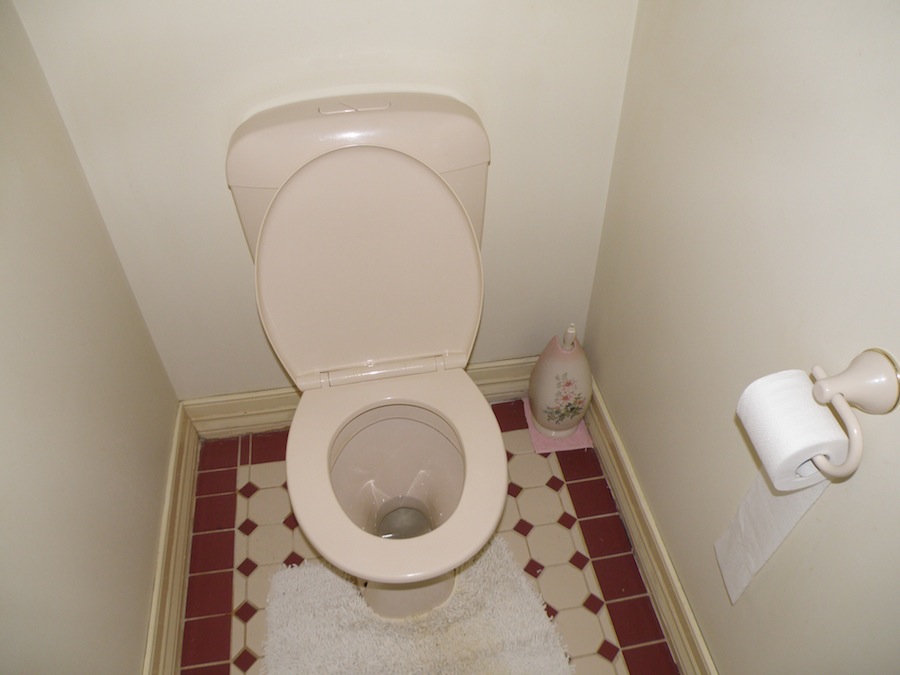
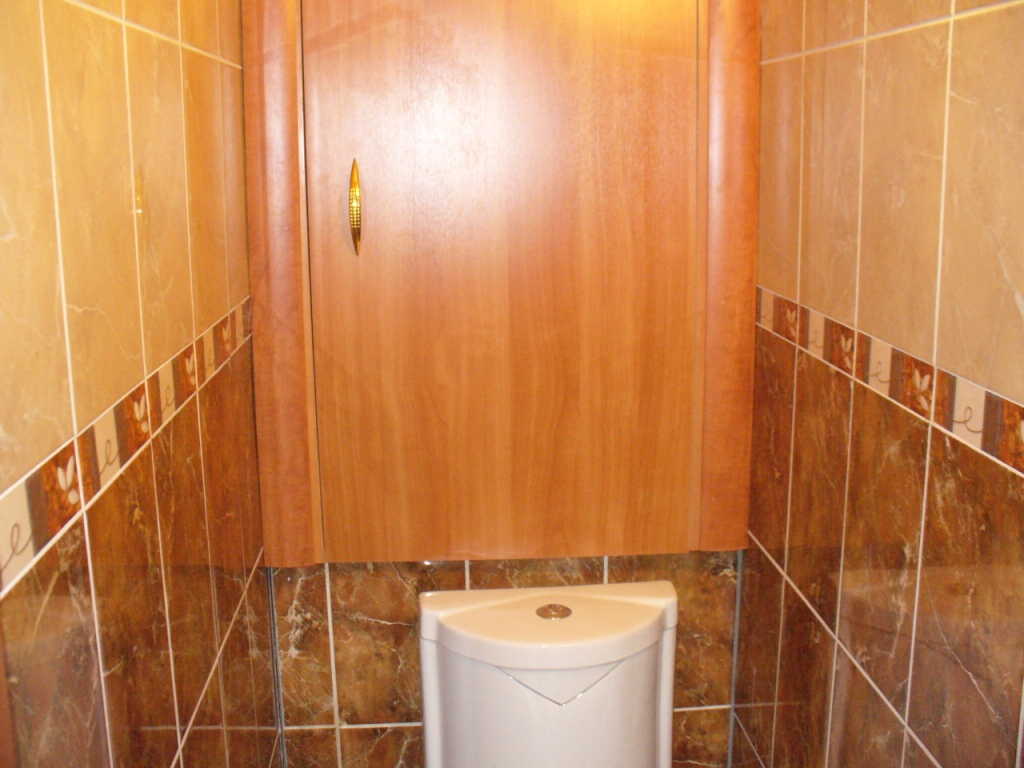
Using plastic panels to hide pipes in the toilet
Installation of decorative panels made of plastic considered one of the most common methodsto hide the pipes in the toilet. Moreover, this option has the following advantages:
- decorative panels made of plastic are quite inexpensive;
- they are easy to install;
- all decorative elements are interchangeable;
- the widest assortment of plastic panels is presented on the construction market.
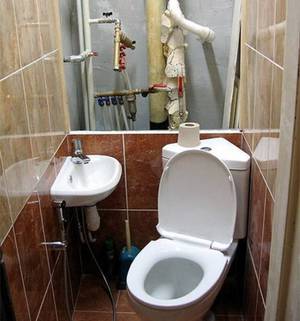 If we talk about the installation of such material, then it is produced on a frame pre-equipped from a metal profile, which is built around communication pipes in the toilet. It is on this frame that plastic decorative panels are sewn. For frame it is advisable to use a galvanized profilewhich is not afraid of moisture.
If we talk about the installation of such material, then it is produced on a frame pre-equipped from a metal profile, which is built around communication pipes in the toilet. It is on this frame that plastic decorative panels are sewn. For frame it is advisable to use a galvanized profilewhich is not afraid of moisture.
At the wall, the start plate is attached to the frame with self-tapping screws and already in advance panels are cut in advance along a suitable length. It is important that the next panel fits tightly with the edge into the lock of an already installed element.
If the design has large dimensions, then it is advisable in its central part additionally fasten the panels using self-tapping screws. But for this, intermediate transverse elements must be present in the frame.
We close the pipes in the toilet with drywall
For a toilet or bathroom, only moisture-proof drywall is suitable. This is due to increased moisture in rooms of this kind. Moreover, this design to hide the aesthetic defects of the pipes in the toilet has the following advantages:
- the material is more durable than plastic panels;
- the design is obtained as rigid and reliable as possible;
- for finishing drywall use wallpaper, tile, paint or any other finishing material that emphasizes the general style of the room.
The very procedure for constructing a drywall construction is completely analogous to installing plastic panels. The only difference is the strength of the frame, which must be constructed with a large number of transverse jumpers, since gypsum boards heavier than plastic panels.
How to hide pipes in the toilet using blinds or roller shutters?
 The use of blinds or shutters is interesting in that they give free access to communication systems. But for their installation, you will need to build either a false wall, or a plastic box, or a drywall construction, which will be the basis. In addition, you will need carve a niche in the design for installation of blinds or rolling shutters.
The use of blinds or shutters is interesting in that they give free access to communication systems. But for their installation, you will need to build either a false wall, or a plastic box, or a drywall construction, which will be the basis. In addition, you will need carve a niche in the design for installation of blinds or rolling shutters.
Also important is the material from which the blinds or roller shutters are made. In most cases, they use more expensive aluminum systems, as it is resistant to moisture and corrosion. In addition, if a motorized system is used, the engine must be in a sealed enclosure.
We close the pipes in the toilet - the straight and oblique design of the false wall
To the most cardinal disguise solution plumbing pipes in the toilet can be attributed the construction of false walls. At the same time, at the finish stage, such a design can be finished with material that was used in the repair of the room, giving the interior a complete look.
To build such a structure, markings are made on opposite walls. In this case, the distance from the wall along which the communication systems are located should be enough to hide the pipe farthest from it. According to the resulting markup, with dowels and screws, a guide profile is attached, into which jumpers are inserted in increments of 60 cm. After this, gypsum plasterboards, previously cut to the desired width, are attached to the resulting structure.
The inclined design of the false wall is constructed as well as a direct analogue. Its only difference is that one of its edges recedes from the main wall to the distance of communication pipes, and the other is adjacent to it. It is advisable to close the pipes with this design when the communications in the toilet are assembled in a row near the corner. Direct false wall in such a situation steals useful space, which is already a little in the toilet.
Square box for concealing pipes in the toilet
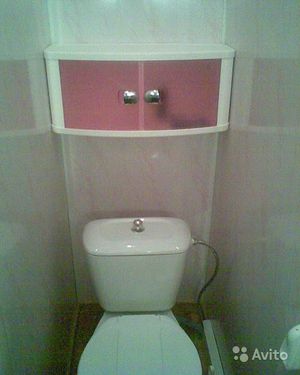 The construction of this design is beneficial when all the pipes are concentrated in one bundle. The technology of arranging square boxes resembles the installation of false walls. From galvanized metal profiles create a frame in the form of a square, which around the perimeter surrounds the pipes in the toilet.
The construction of this design is beneficial when all the pipes are concentrated in one bundle. The technology of arranging square boxes resembles the installation of false walls. From galvanized metal profiles create a frame in the form of a square, which around the perimeter surrounds the pipes in the toilet.
At the same time for the construction of the box optional metal profiles, and you can replace them with bars of wood, which are pre-treated with water-repellent substances. After the formation of the frame on it, by analogy with a false wall, drywall is sewn.
At the corners, the structure is protected by metal corners that sit on the putty. As a decorative finish, any material used in the interior of the toilet, emphasizing the general styling, is suitable.
Using a tiered box
The assembly of a multi-level structure is similar to the construction of a box. In fact, not one but several boxes are formed, which are arranged in series. But this option is more interesting in terms of the design of the room. Thanks to the multi-level boxes, it is possible to build niches that will later be used to place shelves.
Hide from human eyes, sewer and water pipes - a design technique that has gained great popularity among apartment owners. Arrangement of false walls and baskets, the use of roller shutters and blinds or other structures hiding communication systems allows you to transform the space in the toilet, making it unique and attractive, hiding all its shortcomings.
Approaching the issue with imagination and with a little effort, you can make a beautiful decorative column from the old sewer riser, decorating the pipe with mosaic. The resulting niche from multi-level boxes can be used for the construction of shelves or the arrangement of the cabinet for household chemicals. The main thing is that such a design emphasizes the general stylization of the room and then the toilet will delight residents of the apartment with comfort and coziness.
Noticeable communications in the bathroom do not add to the attractiveness of the room. How to close the pipes in the toilet? We offer you some fairly simple and reliable options for the refinement of the premises without compromising its functionality.
We have already considered how you can. The same methods are suitable for the toilet. Let's remember them.
Plastic panels or drywall
The fastest way to close the communication in the toilet is with plastic panels. They are suitable regardless of the decoration of the walls, floor and ceiling. The main thing is to choose the color and pattern.
The advantages of this material:
- environmental friendliness;
- simple installation;
- quick installation;
- low cost;
- the ability to install doors for access to counters or spikes where breakouts are possible;
- the ability to install a collapsible design;
- no additional finishing required.
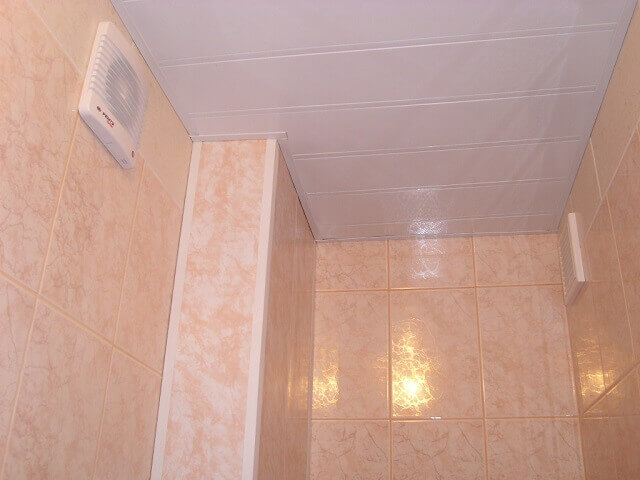
The second convenient material option for the construction with which the pipes will be masked is drywall. The toilet is not a bathroom, but it is still better to use moisture resistant. Benefits:
- environmental friendliness;
- simple installation;
- low cost;
- the possibility of installing a collapsible design;
- the ability to install a door for access to communications.
The only drawback of drywall is the need to finish it. But, on the other hand, you can make it the same as the rest of the walls in the toilet.
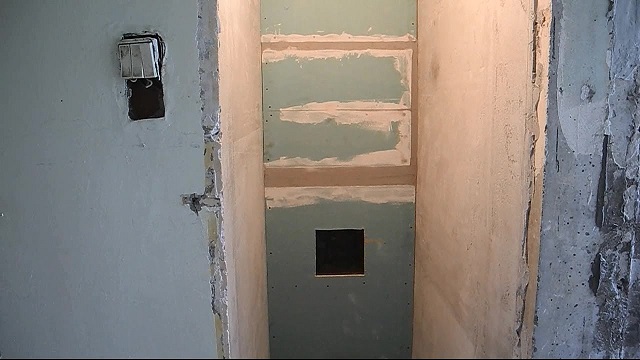
When you decide on the material for the box, you will need to choose its design. Below we describe all the possible options for the installation of drywall constructions and pvc panels.
Regardless of the method chosen, do not forget about access to counters and spikes. To do this, it is necessary to mount the door. It can be hidden, or maybe ordinary white metal, such are sold in almost any hardware store.
The whole wall closes
The first option to hide communication pipes in the toilet is to close the entire wall with pipes. This is done on a metal profile box. In the space where there are no pipes behind the decorative wall, you can make a storage for small items (toilet paper, household chemicals, etc.).
There must be a minimum of 3 cm between the wall to be installed to close the pipes and the pipes themselves! It does not depend on the type of construction chosen.
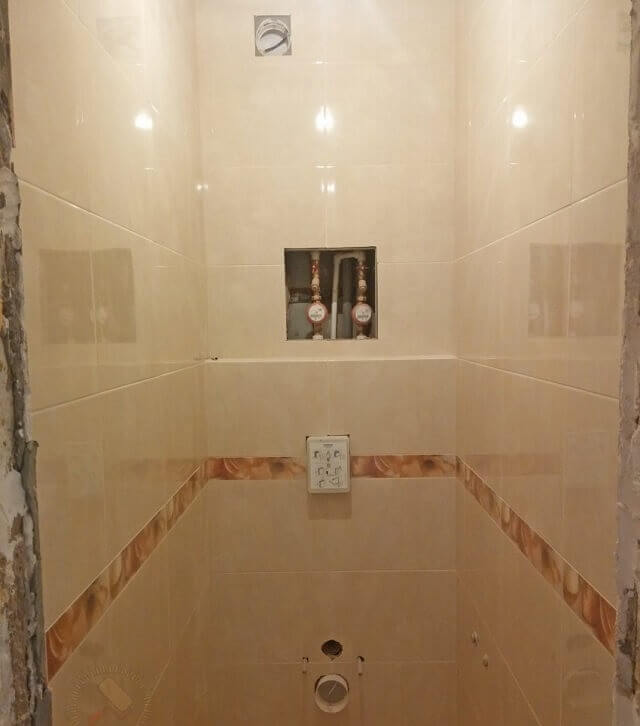
Slanting false wall
If the pipes pass only from the side, then you do not have to close the entire back wall of the room, it is enough to close only the corner with communications.
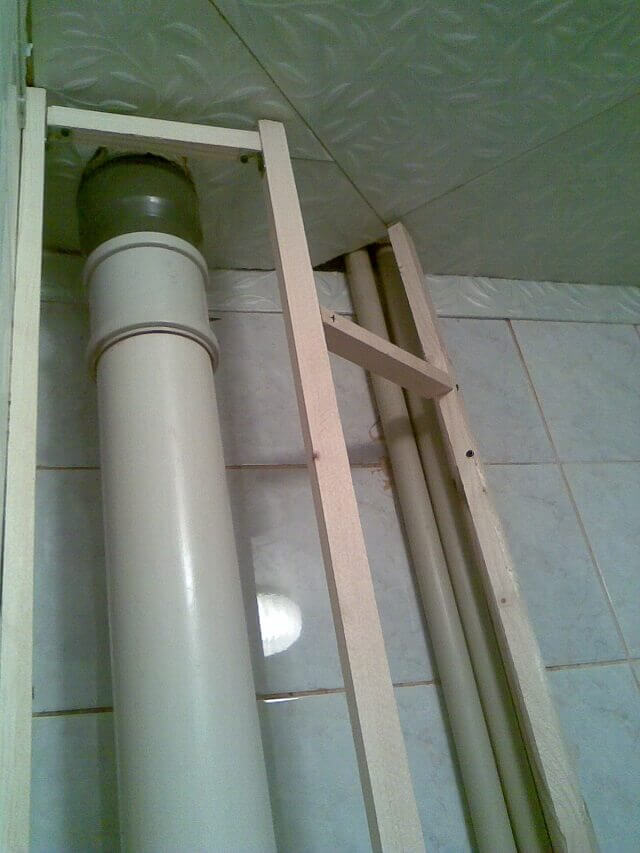
Square box
If you are interested in how to close the pipes in the toilet and leave more space, then the answer is simple: make a box only around the pipes. If they walk in a corner along the walls, then you get a kind of column in the room. If they walk on the floor, then it will look like a step.

Tiered box
If the pipes do not pass clearly along some wall, for example, only to its middle, then you can make a multi-level box and use it as a shelf for decoration, household chemicals or something else. This method is not suitable for installation from plastic panels.
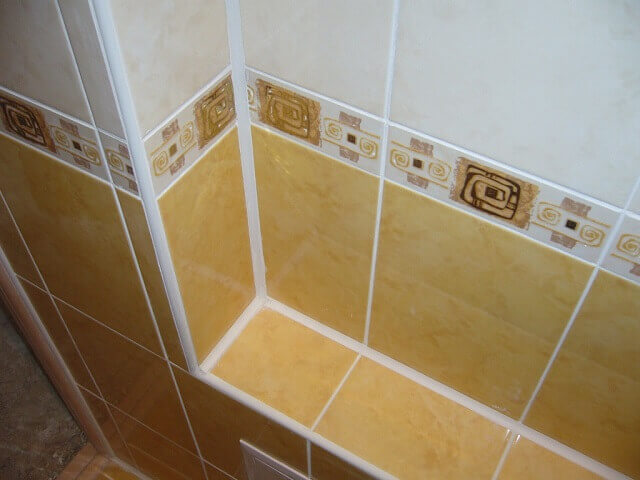
Shutters
To conceal the pipes, roller blinds have been used successfully. They are mounted less often than structures made of drywall or pvc panels, because the installation itself takes more time, the design is more expensive, and the appearance is an amateur, that is, not too attractive. But in this way you get the opportunity to access any pipes behind the panel and space for storing trifles. Of course, for the latter you will have to make several shelves.
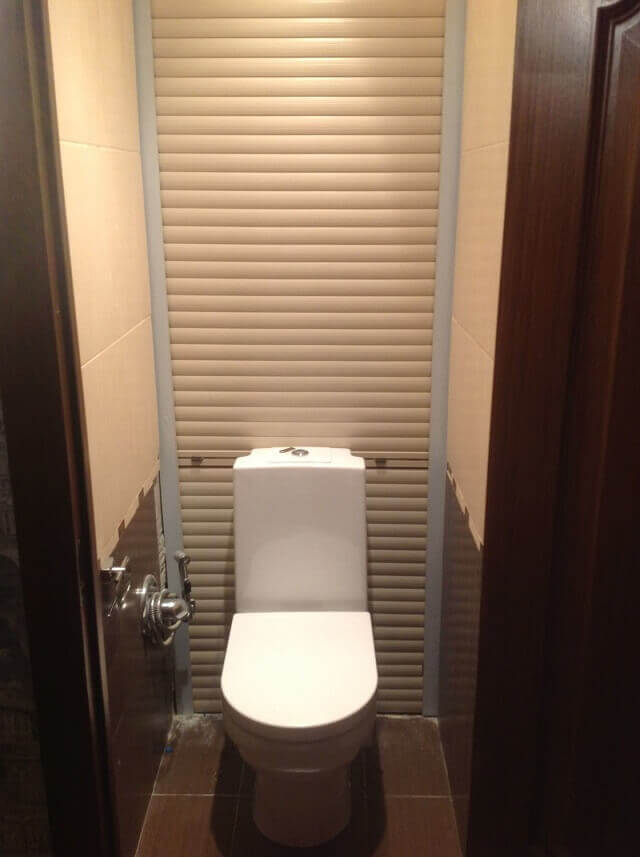
Household locker
A very convenient and attractive way to close the pipes in the toilet room is to put cabinets made of chipboard, wood or plywood. The bottom of the pipes can be covered with a plastic screen that matches the color. So you kill two birds with one stone: create additional storage space and decorate communications.
The only negative of this method is the price. It is the highest compared to all other options, even if you mount everything yourself.
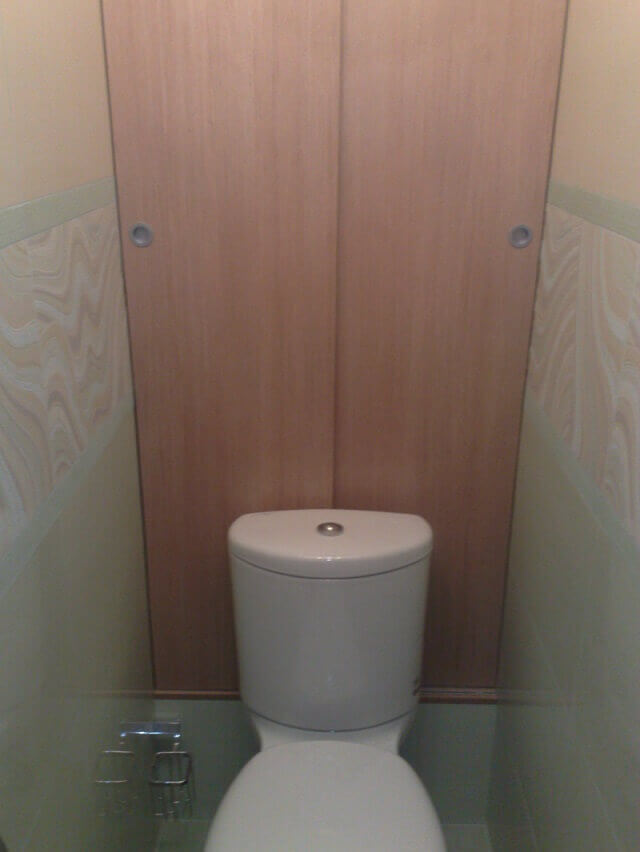
Pipe decoration
Using a little ingenuity and skill in the manufacture of various hand-made products, you can decorate the pipes that pass through the room using mosaics, decorative painting, rhinestones and other interesting techniques or materials. 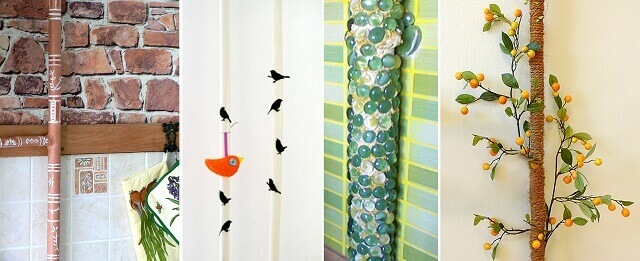
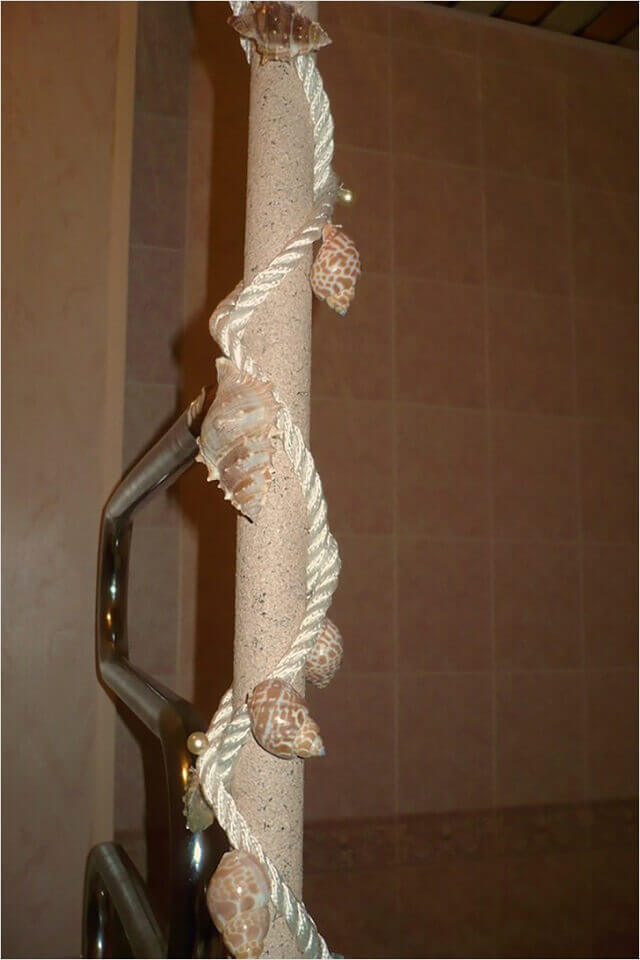
The choice of method and materials for decorating or hiding pipes in the toilet always remains with the owners. None of the above options have strict recommendations or contraindications. Even in a small room, it is usually possible to install a structure made of drywall, pvc panels or chipboard boxes.


